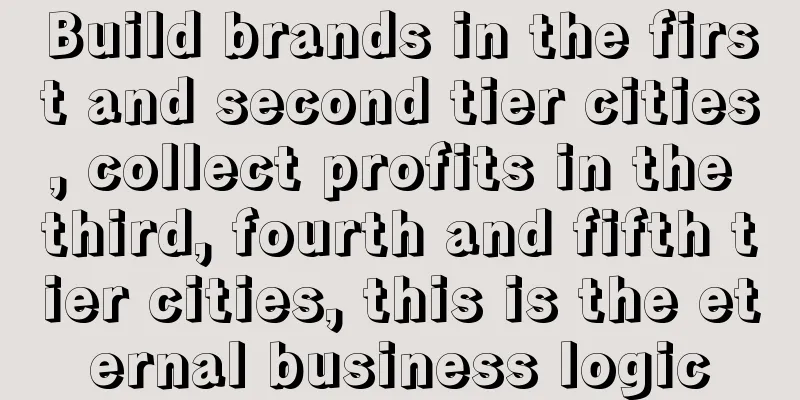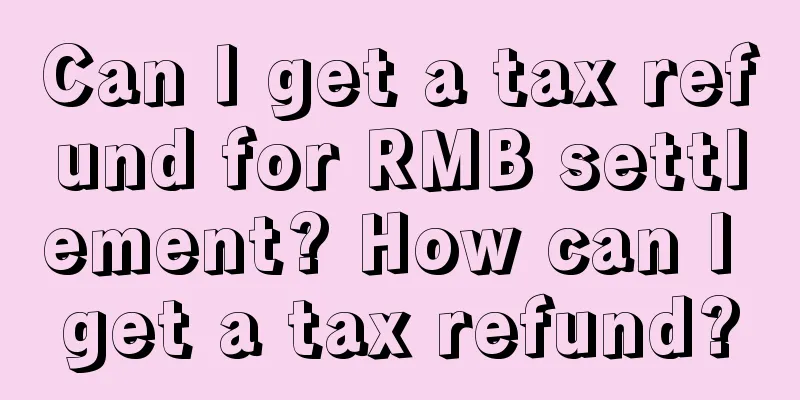Build brands in the first and second tier cities, collect profits in the third, fourth and fifth tier cities, this is the eternal business logic

Building a brand is not first and foremost about the brand. 1. Track selectionNowadays, if you want to be a consumer brand, the first thing is not the brand: Branding comes later, and it is the choice of track. Track means the starting line, but also the ceiling. Track is about the choice of categories and the understanding of differentiation trends. We need to differentiate between popularity and trend. Popularity is imitation while trend is differentiation. Differentiation is the insight into the needs of consumers in a category and product satisfaction; it is also a major competition strategy for brands within the category. Head & Shoulders says that dandruff removal is aimed at the general mass market, severe dandruff problems are left to Chlorhex, and men use Clear for dandruff removal. Look: Head & Shoulders, Celestial, and Clear, through insight into the needs of target consumers, they proactively differentiated the needs (light or heavy, male or female, ingredients, preferences), satisfied the needs with different product forms, and ultimately occupied the minds of consumers with their brands. From demand insight, to product satisfaction (functions, features, benefits), to brand mind-occupying. You can’t talk about brand beyond demand, and you can’t talk about brand mind-building without product (functions, features, benefits). To this end, a big key to the success of a consumer brand lies in whether it truly understands the changes in consumer demand, especially the different groups of people who have different opinions on product functions, features, and benefits due to changes in demand. Once any category market (track) enters the oligopoly competition stage, it means that the entry cost is already very high. It is not only the integration cost of the post-supply chain, but more importantly, the cognitive education cost of consumers on the market side. Because once the mind is established, it is difficult to change. Competition is not about shelves or competitors, but about occupying the cognitive space of consumers. Therefore, in a mature category market, the only way to surpass the red ocean competition and enter the blue ocean is to differentiate categories and then occupy the mental space in the segmented market. The development of the dairy industry has also been constantly finding blue ocean areas in the differentiated market segments. For example, ambient yogurt has given birth to a series of super single products such as Amul, Chunzhen and Mosilian. Similarly, goat milk powder has made Ausnutria successful.
In the cheese category, there are still many first places to be occupied in the minds of consumers. To this end, entrepreneurs need to find a more niche track. For example, Nestle and Maxwell House have made coffee for the masses, while Santonban can only enter the track in the instant market. Technology is the foundation, but price is a double-edged sword. The problem with Santonban is that its high pricing leaves enough room for latecomers to enter. Similarly, if you want to start a cosmetics brand nowadays, you can only drill into a smaller track and find a narrow and deep category gap. For example: makeup, eye shadow - new, thin, narrow, and deep. 2. Products: Useful and informativeMarketing strategy is first and foremost product + business, which is essentially category mindset insight. Through product, business + category mental insight, we can actively differentiate categories, find segmented needs, move from stock market to incremental market, and from red ocean competition to blue ocean. However, most companies react instinctively and forget their original intentions. The instinctive reaction is: lower the price. The chain reaction of price reduction is:
How to occupy a small hill? If you look at almost all businesses that create new categories, when they first enter the market, they all differentiate themselves on the benefits brought by the perceived product functional attributes. To occupy a small hill market at the beginning, being useful, effective, and informative is more efficient than being interesting. Enlarging the "ingredients" list, focusing on functions, and highlighting differentiation can make a good business. So, we want to make hit products, not blockbuster products. The core of a hit product is either to create a new category or to actively differentiate an old category. Whether it is to create or differentiate, the premise is that there is enough differentiation point (perceptible) from the previous category. The innovation of production technology provides the prerequisites for the research and development and production of new species (creating new categories and differentiating old categories). Up and down, two paths: the choice between inside and outside. The first is to fight from top to bottom, using better products (technology, raw materials, craftsmanship, packaging) to harvest the market. A typical example is Jane Eyre yogurt. The second is to fight from bottom to top, using products with better quality and similar prices to quickly cover the market, such as substitutes for big brands. Whether from top-down or bottom-up, almost all businesses that create new product categories, at the beginning of entering the market, place their differentiation points on the benefits brought by the perceptible functional attributes of the product, rather than other emotional appeals. This can be seen from the earliest "drink Red Bull when you are sleepy or tired", to "Genki Forest" sugar-free sparkling water, to raw milk, sugar, lactic acid bacteria, nothing else - this is Jane Eyre". Without exception, they have all chosen simple, direct and effective appeals.
At this stage, being useful, effective and informative is more efficient than being interesting. Phenomena are rules. We should enlarge the "ingredients" list, focus on functions, highlight differentiation and make a good business. According to the Ipsos: 2019 China Food and Beverage Industry Packaging Trend Insight Report, consumers are particularly concerned about nutrition and health-related information on packaging, and consumers aged 24+ and in first-tier cities have a stronger awareness of health and nutrition. 89% of people pay attention to the production date/shelf life, 76% pay attention to health/nutrition related claims, such as sugar-free, no additives, etc., and 73% pay attention to the nutritional ingredient list. 3. Narrow and small9.6 million square kilometers, more than 2,800 counties; in this fertile land of consumption where time and space intersect, no matter how small your business is, as long as you do it thoroughly, penetrate and penetrate, you can make 1 billion yuan a year. The premise is whether you are focused enough: narrow, small, detailed and deep.
That is: the product should be narrow and small, and the channel should be fine and deep. If you penetrate the region, the mind, and the market, even the smallest product can have a chance to make 1 billion yuan a year. Jinshiyuan Winery has an annual turnover of 8 billion, 93% of which is consumed in Jiangsu Province, and only 7% is consumed outside the province. One province can support a wine company with a turnover of 10 billion. The business of a bag of pickled mustard tuber may seem small, but it is frighteningly large when it penetrates the region, the mind and the market. The price of Wujiang pickled mustard tuber increased from 50 cents to 1 yuan, and from 1 yuan to 2 yuan. The gross profit margin increased from 38% to 55%, and the net profit margin increased from 9.5% to 34.6%, outperforming at least 95% of the companies. In the same market that seems to be monopolized by Coco Tree Coconut Juice, Special Forces Coconut Juice focuses on large-bottled products (a bit like the large-bottled version of Hejizheng back then), avoids competitors in terms of channels, does not enter supermarkets first, focuses on banquets, and focuses on Jiangsu Province in terms of regions. Within a year, it achieved a sales volume of 700 million in Jiangsu Province. 4. Thin and deepThe product should be small and narrow; the channel action should be detailed and deep. That is: surface penetration (channel penetration + mental penetration). Focus on the original population, penetrate the original channels, thoroughly explore the original market, and establish a base. Lao Xiang Ji opened more than 400 stores in Anhui before it ventured out of Anhui with confidence, while Cha Yan Yue Se focused on Changsha, with one store every 10 steps at its peak. After the Changsha market was narrow and deep enough, Cha Yan Yue Se, like Lao Xiang Ji, gradually moved out of its base. The number of Cha Yan Yue Se stores in Changsha is 2.2 times that of CoCo and 1DianDian, and 2.7 times that of Shuyi Shaoxiancao and Mixue Bingcheng. The total number of stores in the three administrative districts of Tianxin, Yuelu and Furong is 142, with 63 stores in Tianxin District, making it the administrative district with the largest number of stores. In business wars, the advantage often belongs to the defensive side.
In the three years from 2017 to 2020, Neiwai has 110 retail experience stores in 29 first- and second-tier cities across the country, and has strategic partnerships with first-tier owners such as Kerry, Sun Hung Kai, Swire, Hang Lung, and China Resources. On the one hand, choosing a high-potential business district as the location for offline stores can reflect the brand image and effectively form brand endorsement. On the one hand, as traffic becomes more and more expensive, offline channels can bring brands greater room for category expansion and more development opportunities. With the help of the layout of offline channels, Neiwai has gradually expanded from underwear to home casual wear, dance sports and home products.
The same is true for Yuanqi Forest in terms of channels: do it in detail and in depth. Go to places where competitors cannot sink, go to places that competitors are unwilling to go, and go to places that competitors cannot see. Do it in detail and in depth. In 2019, e-commerce platforms accounted for only 3.4% of the sales channels in China's beverage industry, while offline channels accounted for 96.6%. 7-Eleven data shows that consumers aged 20 to 40 account for 88% of the convenience store consumer population. There are currently about 6.8 million mom-and-pop stores in China, with 800-1,500 SKUs and 2-3 brands in each product category. In the vast Chinese market, mom-and-pop stores, grocery stores, retail stores, restaurants, and tobacco and liquor stores still occupy a large share. Build brands in first- and second-tier cities, and collect profits in third-, fourth-, and fifth-tier cities. Build brands in KA stores, and make money in mom-and-pop stores, grocery stores, and tobacco and liquor stores. Do it in detail and in depth - this is the eternal business logic. 5. Four mental methods: single point breakthrough, concentrated use of troops, winning by quantity, clean action
When funds are limited, the first thing to do is to break through with a single point. There is no need to have a lot of selling points and features. Focus on breaking through with product strength and find a differentiation point (single point) in product strength (function-benefit). From the process, ingredients, components, to the function, do subtraction and eliminate the benefit points to make them sharp - only one hole is needed for profit. In terms of publicity, we should insist on producing quantity first, spreading the word first, and concentrating on one media platform. Quantity comes first and quality comes later. Without quantity, there is no quality. At this stage, we divide our forces (multiple platforms), and the originally limited resources are spread into a thin cookie. If we prepare for the left, we will have less resources on the right; if we prepare for the right, we will have less resources on the left; if we prepare for everything, we will have less resources on everything.
The action is clean, and clumsiness is more important than cleverness. An action mixed with all kinds of ideas, concepts, and selling points will reduce efficiency by half from the beginning. Consumers' attention is limited, and under limited attention, the number of points determines the efficiency. Activity result = basic probability x action purity x focus A friend said, I want to do a buy-one-get-one-free event on Xiaohongshu, Douyin, Kuaishou, and Weibo. He asked me for my opinion, and I said: Can we do it on one platform? The return rate of this kind of activity is not high (there is a basic probability). You can refer to the data of e-commerce and similar activities of other types of products. It is about the same. There is a basic probability in this world. If you divide it into four platforms, the efficiency will drop by 75%. Isn't this a loss? The result of an activity is often estimated at the beginning of the design. It needs to be focused, single-point, large-scale, and clean in order to have a chance of explosion. Author: Houshan Keju, Source: WeChat public account "Lao Gao Business and Brand" |
<<: Let’s talk about podcasts, a traffic depression
>>: 7 categories, 28 money-making products, each of which can make you rich quietly
Recommend
How advanced is the brand placement in the hit drama "Fanhua"?
The sensational drama "Fang Hua" not onl...
WeChat Stores releases a series of big moves
"New developments in WeChat Stores, e-commerc...
How to quickly break zero on Shopee? Tips to quickly break zero on Shopee
After merchants settle in an e-commerce platform, ...
The Baidu Encyclopedia App, which has been downloaded over 20 million times, will be shut down. Is it because it is not making money?
This article explores the reasons why Baidu Encycl...
What does it mean to pick up your order at Shopee? How does it work?
There are many ways of shipping on the Shopee plat...
The recent trend of Xiaohongshu in the pet industry! How to achieve conversion and dissemination?
Although the birth rate has decreased in recent ye...
Chengdu Disney's popularity revealed: a new chapter in Internet marketing based on sincere emotions
Recently, a rapper named Nomi unexpectedly became ...
Will Amazon's European KYC pass affect the US site? What should I do if Amazon's KYC review fails?
To open a store on Amazon, merchants need to under...
Are there many inquiries for companies ranked high on Alibaba International? Interpretation of ranking rules
Alibaba International Station is the territory of ...
What are the standards for free door-to-door collection on Shopee? Introduction to the standards
When opening a store on Shopee, merchants can pack...
Is it easy to work as an Amazon Japanese operator? What does the job involve?
It is not an easy task to operate an online store,...
Tik Tok is having trouble getting past Meituan
After developing the local group-buying business, ...
Can international virtual credit cards be used to transfer money on WeChat? What are the transfer methods?
As a convenient cross-border payment tool, interna...
The strategy behind Xiaohongshu's surprise appearance on the Spring Festival Gala
Xiaohongshu has joined the Dragon Year Spring Fest...
What should I do if a cross-border e-commerce company sends the wrong goods? What are the situations?
There are many merchants doing cross-border e-comm...









